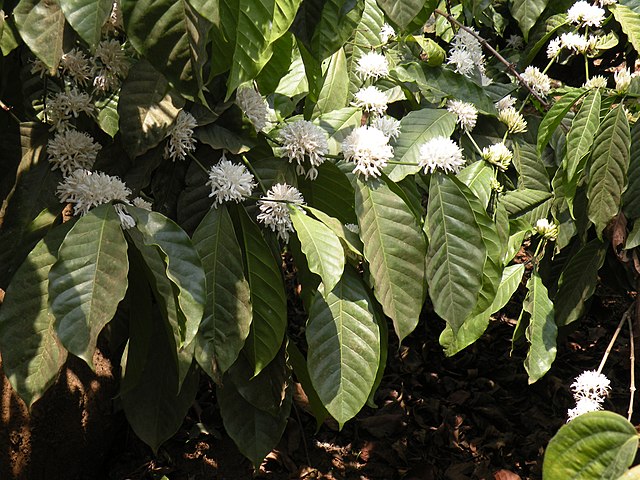Coffee
Coffea arabica
Family: Rubiaceae | Place of Origin: Ethiopia
Origins and history:
The origin of coffee is believed to be in the ‘ancient land of Abyssinia’ which is currently known as Ethiopia, Africa. It is often speculated that it was first brewed however in Yemen, Asia. The coffee tree grows in the humid, high altitudinal forests of Ethiopia. It is considered native to Ethiopia, Sudan, and Kenya, all located in Africa. The knowledge of when it was first discovered is unknown. It is likely that as the Ethiopians became more familiar with the coffee plant, which they called bunn, they began utilizing all parts of the plants. They brewed the leaves and fruits into a weak tea, ground the beans and mixed them with animal fat for an energizing snack, made wine out of fermented pulp, and made a sweet beverage called qishr. By this time, a Persian Physician named Rhazes first mentioned coffee in print in the 10th Century. But it wasn’t until about the 15th century where coffee was most likely brewed into what we know it as today. From the 15th century to today, it rapidly spread through trade, first with the Arabian Peninsula and making its way all around the world in the current day. Currently, Brazil is the largest producer of coffee.

Identification characteristics
- Twigs, leaves, branches: In its natural habitat, Coffea is considered a shrub or a small tree that grows about 12 ft in natural environment. It takes about 4-5 years until the shrub reaches maturity and begins to fruit. After maturity, the plants lives about another 15-20 years of producing fruit. The young branchlets are glabrous, meaning it lacks hair. The leaf blades are dark evergreen color and elliptical, or round/opposite (6-18×2-10cm). The leaves taper to a point and are visually shiny. The leaves themselves lack hair, just like the young twigs. Venation is from midrib to the margin. The stipules are triangular and long(4-8mm).
- Flowers: Usually 5-merous in axillary clusters of the leaves, white, and aromatic. Hermaphroditic. Sweet scented. Coffea Arabica is autogamous(self-fertilize), whereas other species mainly are insect pollinated.
- Fruit: Berry. Fleshy outer portion of berry is removed and the harder part, the bean, is what is used for making coffee. Colors range from red, yellow, and sometimes purple. Seed itself can be dark brown, post roasting, or pale brown before roasted.
Uses and preparation
Coffee today is mainly grown for its seeds which ultimately produce coffee. The leaves and berries are the edible. Leaves and beans contain caffeine which can be brewed/eaten directly. Coffee is often used for flavoring and is widely brewed into a drink. The wood of the shrub can be used for construction. In some studies, it is shown that coffee can be used medicinally as a treatment to liver disease. Preparation involves allowing the plant to grow to maturity at about 3-5 years. Once it reaches maturity, it will fruit and then harvested. Roasting involves determining the type of brew you want, whether that is light, medium, or dark, and that depends on the color of the bean. There are five stages of roasting, drying, yellowing, first crack, roast development, and second crack. After those stages are complete, beans can then be ground into a powdery substance. The ground coffee can be brewed in boiling water to taste. The grounds are then separated from the water and the final product results in coffee. Although, this is a simple breakdown, there are varying processes when it comes to making certain roasts and blends. Coffee is the first most valuable commercial crop in the US and the second most valuable international product following oil.